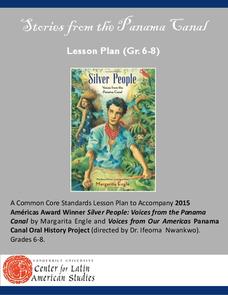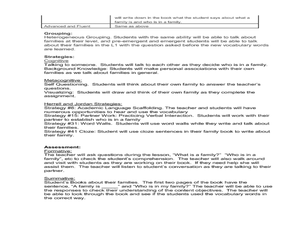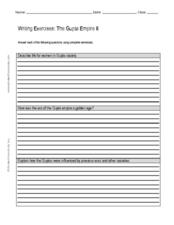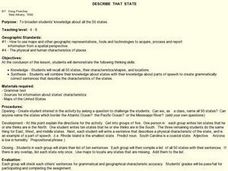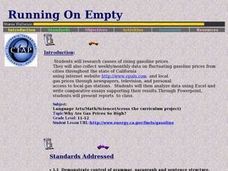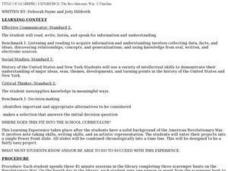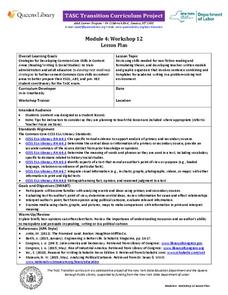K12 Reader
Missing Nouns
Scholars use nouns from a word bank to complete sentences in a fill-in-the-blank instructional activity that tells a tale about the California Gold Rush.
Vanderbilt University
Stories from the Panama Canal
The stories of the Silver People, the West Indies immigrants hired to work on the Panama Canal, come to life in a lesson plan about the building of the Panama Canal. Groups research why the canal was built, how it was build, the working...
US Institute of Peace
Defining Conflict
Before there can be peace, we have to understand conflict. Introduce the concept of conflict through a two-part activity that combines discussion, collaboration, and writing. The first in a 15-part series examines the multiple meanings...
Curated OER
Fast Facts
In this reviewing social studies facts instructional activity, students observe facts in the columns labeled New England, the Middle Colonies, and Southern area of the United States, categorize using one fact from each column, and write...
Curated OER
What does the rice farmer use to get the rice to the mill?
Students use a ramp, sheet, and rice to demonstrate how rice farmers get the rice to the rice mill. In this rice lesson plan, students perform this experiment at home and answer short answer questions.
Curated OER
Wappo Language
Third graders discover that the Wappo tribe had no written language and explore the tribe's oral traditions and language. They create their own sentences using Wappo words. They research other Native American languages noting the...
San Francisco Symphony
Mr. Lincoln Through the Eyes of Aaron Copland
Use Aaron Copland's symphonic piece, "Lincoln Portrait" to engage learners in a cross-curricular experience. They'll listen to the piece, watch a video, read the Gettysburg Address, and write a series of fact or opinion sentences. An...
Achieve The Core
Linda R. Monk, Words We Live By: Your Annotated Guide to the Constitution - Grade 8
“We the people . . .” Thus begins the Preamble to the Constitution. Using a close reading approach, class members examine an excerpt from Linda Monk’s article that traces how the interpretation of these words has evolved. Some of your...
Curated OER
Identifying Family
A reading of Stella Blackstone’s, Bear’s Busy Family launches a genealogy writing project. Young researchers use key words from the story, daddy, sister, uncle, etc., to write stories to illustrate and combine into a family book. While...
Curated OER
Generations: An Exploration of our Families Through Literature
Students complete a unit of lessons on families. They read and analyze various stories, label a map, assemble sentences, write letters to grandparents, analyze character traits, and write and illustrate a sheet for a class book.
Curated OER
Writing Exercise: The Han and Roman Empires
Combine subjects with a cross-curricular writing exercise. Although limited as an engaging or interactive activity, this Han and Roman Empires worksheet has learners responding to 3 clear and simple prompts, each of which can easily lead...
Curated OER
Writing Exercises: The Gupta Empire II
Combine subjects with a cross-curricular writing exercise. Although limited as an engaging or interactive activity, this Gupta Empire worksheet has learners responding to 3 clear and simple prompts, each of which can easily lead into...
Curated OER
Describe That State
Students broaden knowledge about all the 50 states. They combine their knowledge about states with their knowledge about parts of speech to create grammatically correct sentences that describe the characteristics of the states.
Curated OER
The Horrible No Good Very Bad Day
First graders read Alexander and the Terrible Horrible No Good Very Bad Day, write sentence or paragraph about their experience with a bad day, and combine their work with that of classmates to create class book.
Curated OER
World War II Erupts Chapter Review
In this World War II worksheet, students review a chapter as they write 10 vocabulary words that match 10 descriptions, eliminate 4 false sentences, and identify 2 themes from the history of the World War II era.
Curated OER
The Mystery of Easter Island and Commas
In this commas and Easter Island worksheet, students read three uses for commas in a box at the top of the paper. They punctuate 12 sentences properly by adding commas and periods where they belong.
Curated OER
Running On Empty
Students research causes of rising gasoline prices. They collect data on fluctuating gasoline prices and analyze the data using Excel. They write comparative essays supporting their results and create PowerPoint presentations to present...
Curated OER
Geography Words
This learning exercise uses maps of South America and Canada to combine basic geography vocabulary and using prepositions. Students use the maps to answer questions about the locations of various countries on the two maps. This would be...
Curated OER
Mapping Roxaboxen
Fourth graders read Roxaboxen and draw a map of the Roxaboxen community. In this language arts and geography lesson, 4th graders use specifications given, adding features to the map as described in the book and creating a legend.
Curated OER
The Revolutionary War: A Timeline
Fifth graders, in groups, spend one to two days researching their person or event. After the research process, each student has to write two to three sentences describing their person's most important contribution to the American...
Curated OER
Women in History
Young scholars discuss the impact women have made on the United States. Individually, they choose two women to research on the internet to discover their contributions. They develop a PowerPoint slide to be combined with ones made by...
Curated OER
Whodunnit?
Want to create an exciting mystery activity? Investigators will identify the elements of a mystery, review mystery stories, then write their own mysteries. They engage in forensic science experiments related to mysteries and learn to ask...
Curated OER
African-American Soldiers After World War I: Had Race Relations Changed?
Students utilize an online database to conduct research and analyze the conditions for African-Americans before and after World War I. They consider the role of the 92nd and 93rd divisions in affecting social change.
EngageNY
TASC Transition Curriculum: Workshop 12
How can opinions slant facts? Workshop participants learn how to examine primary and secondary sources and identify the author's point of view. They also examine how visual art impacts the meaning and rhetoric of sources. Full of...

